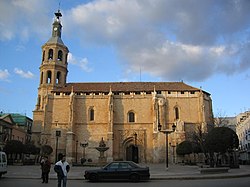Valdepeñas
| Valdepeñas | ||
|---|---|---|
| Municipality | ||

Valdepeñas Spain Church of Assumption
|
||
|
||
| Location in Spain | ||
| Coordinates: 38°46′N 3°24′W / 38.767°N 3.400°WCoordinates: 38°46′N 3°24′W / 38.767°N 3.400°W | ||
| Country |
|
|
| Autonomous community |
|
|
| Province | Ciudad Real | |
| Founded | 13th century | |
| Government | ||
| • Mayor | Jesús Martín Rodríguez (2007) (PSOE) | |
| Area | ||
| • Total | 487.65 km2 (188.28 sq mi) | |
| Elevation | 705 m (2,313 ft) | |
| Population (2009) | ||
| • Total | 31,147 | |
| • Density | 64/km2 (170/sq mi) | |
| Demonym(s) | Valdepeñeros | |
| Time zone | CET (UTC+1) | |
| • Summer (DST) | CEST (UTC+2) | |
| Postal code | 13300 | |
| Official language(s) | Spanish | |
| Website | Official website | |
Valdepeñas is a municipality in the province of Ciudad Real, in the autonomous community of Castile-La Mancha, Spain. It is also the seat of the judicial district that covers the localities of Moral de Calatrava, Santa Cruz de Mudela, Viso del Marqués, Torrenueva, Castellar de Santiago and Almuradiel.
Its name means "Valley of Rocks", because it is located in a wide area meander of hill the Jabalón River surrounded, just bordering on the plain south of La Mancha and the subsoil is rich in limestone rock.
Valdepeñas is located in the Campo de Calatrava, an extensive plain north of the Sierra Morena, and lies on the left bank of Jabalón River, a tributary of the Guadiana.
The hamlet (pedanía) of Consolación depends from Valdepeñas and is located at the intersection between Autovía A-4 (Autovia del Sur) and road CR-5214. It was built by the Instituto Nacional de Colonización in 1949.
The municipal area houses numerous prehistoric remains, platforms and watchtowers located in the hills, compatible with settlers of the Bronze age called Culture of the Motillas, dated between the 10th and 13th centuries BC. Vasco Merlo in their History of Valdepeñas described these structures erroneously as Celtiberian settlements, despite them being much older than that and possibly belonging to the Culture of Argar.
Eight kilometres to the south of the city, we find The Iberian city of “Cerro de las Cabezas” (Hill of the Heads), a great oppidum or town fortified with a true castle in the summit of the hill that it occupies, inhabited between the 7th and 2nd centuries BC. It is an important archaeological deposit of the Oretana Culture and shows signs of the first vestige of the grapevine in this region.
...
Wikipedia


